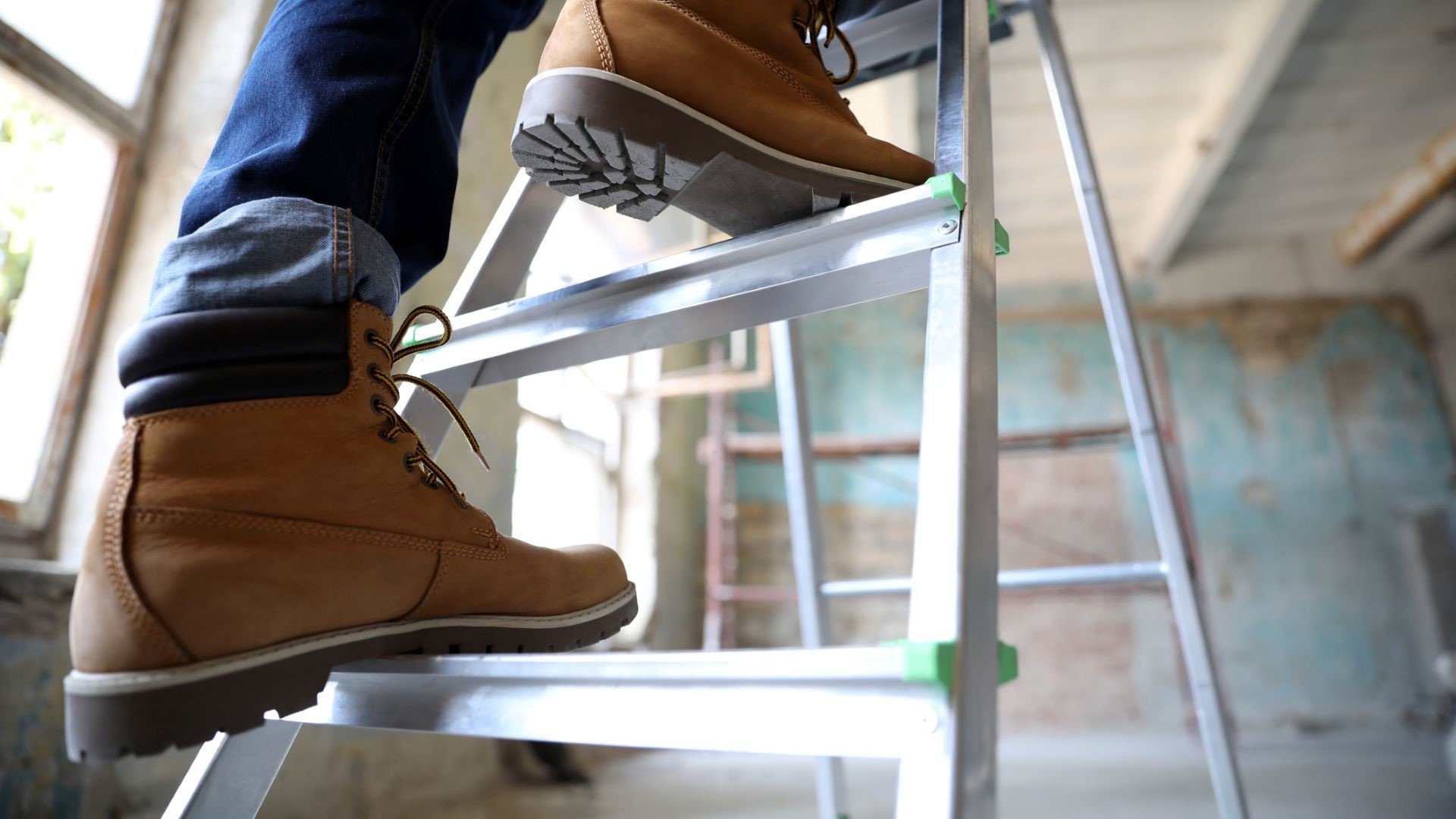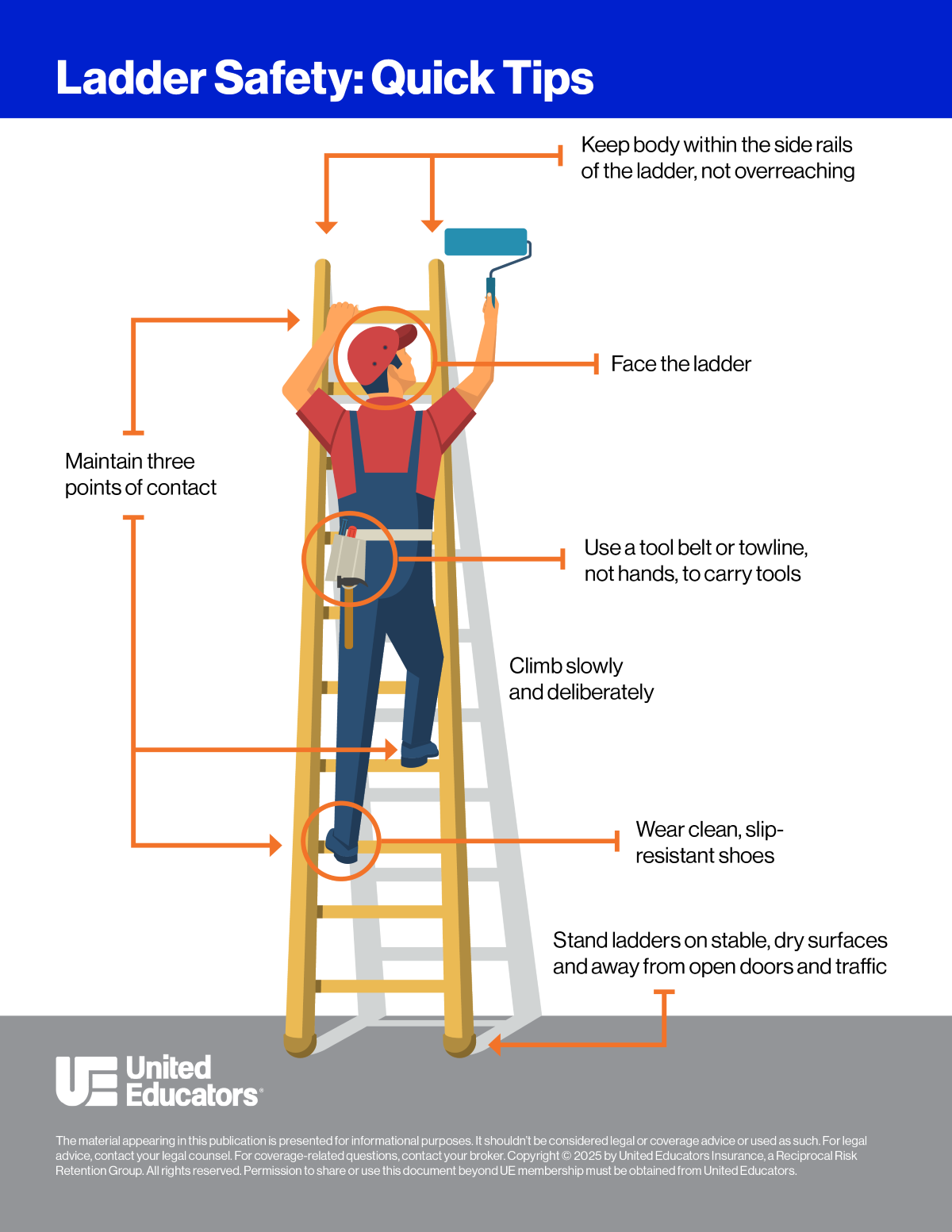Steps to Promote Ladder Safety

Put measures in place to prevent falls from ladders, a leading case of workplace injuries.
Promote safe ladder use. Where possible, avoid using ladders on campus and opt for alternatives such as aerial lifts and mobile work platforms to raise workers. While alternatives are more expensive, they are generally safer.
Take the following steps to protect employees and your institution.
Manage Your Liability
Shield your institution from liability for ladder-related injuries by properly training anyone you authorize to use ladders, limiting the use of school-owned ladders on your campus, and allocating risk to third parties when possible.
If employees use ladders, make safety education a central part of training. Most employees believe ladder safety training could have prevented ladder accidents in their workplace.
For example:
- Host training events and require employees to complete online trainings.
- In break rooms and common areas, hang posters and handouts that reiterate key safety tips.
- Instruct employees to avoid using ladders if they feel tired, dizzy, or generally are prone to losing their balance.
When working with contractors you expect to use ladders, transfer to them responsibility for workplace safety, management, and training.
Avoid letting students use school-owned ladders when possible. If students must use your ladders for activities, instruct them on ladder safety with the same training you require for employees. Consider using waivers or assumption of risk forms to protect your institution and help ensure students fully understand the risks involved.
Educate on Safe Ladder Use
Cover all aspects of safe ladder use in your safety education.
Include:
- Identifying unsafe conditions
- Choosing the appropriate ladder
- Placing the ladder correctly
- Safe climbing practices
Discuss unsafe conditions for ladder use, such as:
- During periods of high winds or storms if working outside
- Anywhere ladders could accidentally touch power lines
- Near electrical equipment if using a metal ladder
Include tips on selecting the correct ladder for a job. The ladder should:
- Be in good working condition.
- Have a duty load rating higher than the combined weight of the person (including protective clothing), equipment, tools, and supplies going on it.
Explain proper ladder placement means:
- Standing the ladder on a stable base with even ground, and not on boxes or barrels
- Not using the ladder on a soft or slippery surface
- Not placing a ladder by a door unless the door is locked, blocked from opening, or properly guarded
- Putting a barricade up to keep traffic away from the ladder
- Keeping slippery materials off the ladder
- If using an extension ladder, extending it high enough that users don’t need to use the top two steps — but not so high that it goes more than 3 feet past where it needs to land
Detail these safe climbing tips:
- Only let one person use the ladder at a time, except for ladders designed for use by multiple people.
- Wear clean, slip-resistant shoes.
- Use a tool belt, towline, or assistant to carry tools instead of carrying them by hand.
- Always maintain at least three points of contact — either two feet and one hand or one foot and two hands — on the ladder.
- Face the ladder when climbing it and keep the body in the middle of the ladder and within the side rails.
- Climb slowly and deliberately, as missing the last step on a ladder is the most common cause of ladder accidents.
Finally, teach users to avoid especially risky practices such as:
- Placing a ladder horizontally
- Using a stepladder with its spreaders unlocked
- Climbing on the rear cross-bracing of a stepladder, instead of climbing the steps as intended
- Overreaching while on the ladder
- Attempting to tip the ladder over
- Moving the ladder while someone is on it
- Leaving tools on the ladder
More From UE
Ladder Safety: Quick Tips Infographic
Take Care During Campus Repairs and Construction
Additional Resources
American Ladder Institute: Choosing the Right Ladder
Occupational Safety and Health Administration (OSHA): Portable Ladder Safety QUICKCARD™
OSHA: Reducing Falls in Construction — Safe Use of Job-made Wooden Ladders
About the Author
-

Annika Vasagiri
Former Risk Management Intern
Annika Vasagiri was a summer intern with UE’s Risk Management department. While at UE, she was a fourth-year International Affairs and Economics student at George Washington University. As an intern, she researched risk areas affecting educational institutions and the risk mitigation strategies available to them. Prior to joining UE, Annika interned at the U.S. Department of Commerce and completed an exchange semester at the National University of Singapore.
